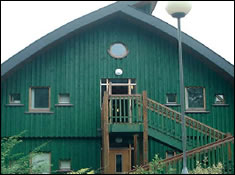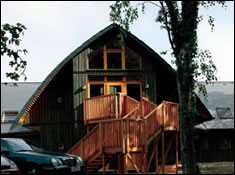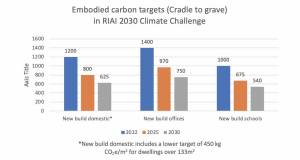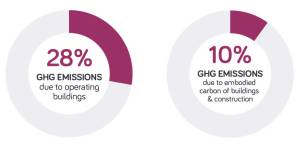Caveat Emptor

We all have a vested interest in the commercial and domestic infrastructure of Ireland . If you ever intend to buy, sell, rent, lease or develop property during your lifetime then the energy efficiency of these buildings that each of us live and work in are set to face legal and commercial scrutiny at both the local and European level under the incoming Energy Performance of Buildings Directive [EPBD]. However the Irish Government’s track record of implementing positive frameworks for building standards is far from exemplary and is plagued by accusations of cronyism. Construct Ireland’s Frank Coles spoke to builders, trade associations and regulation makers, to examine the possible impact of the Directive and to explore the problems and opportunities that these changes pose for consumer and industry alike.
The EPBD has emerged against a backdrop of unsuccessful Environmental initiatives over the last few years. Andrew Warren from EuroACE [The European Alliance of Companies for Energy Efficiency in Buildings] provides context. “In 1997 EU member states took on a portion of the Kyoto burden in order to meet the 8% reduction in emissions between 1990 and 2010 which the EU-15 committed itself to deliver.” In November 2000 The National Climate Change Strategy [NCCS] was brought in as the framework through which Ireland would meet its commitments under Kyoto . The NCCS amongst other things promised carbon energy taxation and a “mandatory energy rating system” for building rental in the commercial sector, to be in place by 2003. Neither of these proposals has ever been implemented; carbon tax disappearing at the 11 th hour amidst some controversy while the commercial rating system vanished without a whimper. According to the Department of the Environment the energy rating initiatives foreseen by the NCCS “were overtaken by the adoption by the EU, at end 2002, of the Energy Performance of Buildings Directive”, a system not due in until January 2006 and according to the DOE, “the energy performance certification provisions must be fully operative no later than 4 January 2009”, hinting at ongoing delays in implementation.
Essentially some would say that because very little had happened with earlier initiatives in certain member states, the EU was compelled to draft the EPBD. Andrew Warren explains that a lot of governments had been urging the Commission to “stop inventing new Directives and try to make sure the one’s we’ve got are implemented properly.” The Commission is now taking a hard-line approach to this situation and will hold these countries to their word. He goes on to say that “if it is transparent that actually what they’ve been doing is twiddling their thumbs” then under the EPBD, the Director General of Energy and Transport, Francois Lamourex “made it plain that he expects to go for prosecution.” Lamourex has also informed EuroACE that he anticipates having to “take out proceedings against around a half of the Member States.”
At the European level then, it is essential for the Irish and many other governments to bring their emissions levels under control and comply with the EPBD, but is there any sign that the Irish Government has the will to make this happen? From both national and international levels there is compelling evidence to the contrary. According to a source within the Commission, commentators from other governments have noted during the negotiations over the EPBD that the Irish Government representative had sought to water down any hard commitments in the Directive.
The significance of the emissions reductions across the building sector becomes clearer through the results of a study funded by EuroACE and conducted by international management consultants CALEB. They found that by using existing technologies the EU could reduce greenhouse gas emissions from this sector by 400 million tonnes; more than the combined EU commitment made at Kyoto . To put this in perspective; to reduce emissions by other means Europe could either take six million cars off the road for 15 years or plant forests equal to three times the size of France . From these findings it is easy to see why the Commission has taken this initial approach to emissions reduction that will also lay the groundwork for further reductions in the future. From his wider European perspective Warren asserts that “across Europe the building sector is responsible for half of all energy use and therefore half of all carbon consumption. You’re talking about areas in which it is fairly easy to make reductions and makes buildings more comfortable to live and work in and cheaper to run. It has a potential to be win, win, win all round. The trouble is that it requires change, change, change all round and not everyone is all that keen.” >

So for Ireland to avoid prosecution and fines or to meet its targets and to stay competitive as the European marketplace changes, it appears necessary for the Irish Government to take an active role in establishing the required framework and make it easier for changes to be made across the industry, from construction site through to the board room. However on the domestic front industry leaders are asking why the Irish Government is failing to take its environmental obligations more seriously. Gerry McCaughey of Irish timber frame manufacturer Century Homes asks, “Why would the Government not be concerned about our climate, about possible fines for breaching a legally binding agreement, and about reducing the amount of money spent by Irish citizens on fuel? The fact is, the moment they make all these changes one massive industry is going to be seriously harmed.” To back up this statement Mr McCaughey has made available to us documents he recovered from the Department of the Environment under the Freedom of Information Act. McCaughey’s company has been involved in building a number of demonstration projects over the years including one in particular that was jointly sponsored by the University of Ulster and the British Department of Economic Development in the late nineties. According to McCaughey the report the project produced was astounding, “in terms of the amount of CO2 reduction that you could generate to heat a house to a very comfortable level.” He sent these findings to the then Minister for the Environment, Noel Dempsey. Ireland had just signed up to Kyoto and already there were signs that Ireland couldn’t make its commitments. “I actually genuinely thought, which shows how naïve I was, that these guys will be really interested in this. We face a fine if we don’t get this right. Some time later I get back this flippant response, basically saying thank you very much but no thanks.”
McCaughey didn’t pass much comment on the matter at the time as he had genuinely submitted his research to the Department “for no other reason than just to provide the information to them.” However, a few months later while sharing a cup of coffee with his solicitor the suggestion was made that he could see what the Department of the Environment had on record under the then new Freedom of Information Act. “I went in to look at the file”, he recalls. “In there I found the letter which I had sent them and attached to it was also the report which I’d sent to them which was from the British Government. Attached to that were some handwritten notes by DOE officials and confidential emails and documents prepared for the relevant minister, and it was in the middle of that that this whole thing became clear as to what was going on, in that we saw from that document that the Government was very, very aware of the issue of its commitments under Kyoto. It was basically saying back in 1997/1998 that we should be doing something in terms of improving the Building Regulations if it wanted to meet its requirements.”

Additionally in his letter on the positive results of the Northern Irish study, McCaughey had raised the issue of the Irish Government permitting the use of nine-inch hollow block construction. He had found that this type of construction is banned and deemed unfit for human habitation in other countries such as the UK . The internal documents revealed that the use of the hollow block and the disinterested response that he had received may have a direct causal link. The documents show some of the inner workings of the Department and McCaughey found a specific statement in point six of an internal guidance note to the Minister from Michael McCarthy, the Principal Officer of the Construction Division:
6. DOE/LG will probably have to review/revise Technical Guidance Document L on the consolidated Building Regulations 1997 sooner (1998/99) than we had planned (2002/2003) – due to the CO2 emission targets set by the Kyota [sic.] Convention (November 1997). However, we don’t want to signal this to the outside world just yet because the next “leap” in building standard insulation will probably involve making it difficult for “hollow block” construction used widely in Dublin to survive. This has implications for manufacturers of hollow blocks (who also generally make solid blocks), for builders (will take longer to build double[inner and outer leafs] solid block walls; and there is currently an acute shortage of blocklayers in Dublin ); and for the cost new houses (due to the increased cost of skilled labour/materials for solid block construction).>
“They used this funny word , they don’t want to ‘signal’ this to the outside world yet because it could have a negative impact on nine inch hollow blocks”, McCaughey reveals. “The word “signal” is an interesting one. Saying “we don’t want to signal it yet”, I mean to me that’s a euphemism for “we don’t want to do it”. T here they are acknowledging themselves that they should do something about it and then five years later they actually haven’t done anything about it; and then you can see for the reasons down there, where they start mentioning about the negative impact it would have on the concrete industry.”
This isn’t the first time that this problem of the hollow block has been brought to the attention of the Government either. As our own research reveals, in the following question taken from a Dáil debate on the 15 th February 1978 , questions were even then being asked of the efficacy of hollow block construction:
Mr Keating: Two final questions: is the Minister aware that the nine-inch cavity block used in construction at present, in the context of insulation, is banned in Britain and is most unsatisfactory from the point of view of house building here?
It’s not difficult to see why the European Commission is taking a tougher stance on implementation of standards. Ian Lumley of An Taisce reinforces these suspicions of purposeful prevarication.
“That seems to be the case in Ireland , that there is vested interests of various sectors in Ireland lobbying to maintain their short term interests,” Lumley affirms.
On the construction site the opinion of hollow blocks is just as damning.
“It’s a cheap form of construction,” informs Tom O’Connor of OCM, a general contractor working across the building spectrum. “And it’s being used in Dublin but it’s also being used in Wexford, in domestic housing. There is no way I would use them on domestic construction because no matter what you do it will be a wet wall.” As an example O’Connor cites an experience of their most common use in outhouses and farm-buildings. “We built a stable with them and we couldn’t stop the water coming in through it,” he states. OCM currently know of projects using these blocks including developments of semi-detached buildings and coastal properties in exposed locations. OCM claim to have established their own minimum standards for domestic construction, using “cavity wall construction in block and […] timber frame, but there’s no point in even comparing either of those with hollow block.”
Michael Meehan of the Irish Plumbing and Heating Association [IPHA] agrees with OCM’s conclusions. When he first came to Dublin he was shocked to find builders using hollow block for domestic construction and is cynical about its continued use. “It’s about speed. You can fire up and build a wall from nine-inch blocks very fast. The bottom line is money, money, money. They just want to get the house built and then it’s Caveat Emptor! Let the buyer beware.”
Based on an end of year forecast of 80,000 completed dwellings in 2004, Gerry McCaughey provides an estimate of the potential impact on the housing market. Just looking at the Dublin area alone, “you’ve over 20,000 houses per year that are going to be built using hollow block. It is absolutely scandalous and these people don’t know it because they’re just so happy at this stage to get in there and get a house.”
Surely even one home that has the potential to leak like a stable is setting a dangerous precedent with impending regulations that will penalise those who have to expend more energy and CO2 to keep their homes warm and dry. Ian Lumley stresses the point that “relative to other European countries we are building a much higher proportion of our building stock within a short time. That should put a particular additional onus upon us ensuring that we meet the requirements of the Directive in the most positive and pro-active way.” A statement confirmed by Minister for the Environment Dick Roche’s recent confirmation that we have added a third of our housing stock since 1997.

This maze of political manoeuvring makes the standards proposed under the EPBD seem extremely reasonable and there is a common call for building standards on a par with the UK and our other European contemporaries. The same logic that is being applied by EU towards member states is also expressed by contractors towards Government. “What’s the point in bringing in laws when they’re never going to be properly policed or implemented?” asks Michael Meehan. Under Part L of the building regulations, Gerry McCaughey contends that, “thermal performance of buildings is taken to be a joke by the building industry as a whole and by the regulators in general.” Thermal performance requirements under Part L are defined by the U-Value levels set by the Government as a recommended standard for buildings to achieve.
The changes to Part L introduced in 2002/2003 have also attracted controversy and reinforced the idea that the Department are favouring a particular industry. For instance McCaughey’s Freedom of Information Act file also revealed that a concrete industry representative cited a revision of the proposed U-Value of 0.25 to 0.27 to a Joint Oireachtas Committee three weeks before the then Minister Noel Dempsey was to publicly announce the revision to Part L in November 2000, a claim the Department does not dispute.
This change was later justified “partly to facilitate the buildability of certain constructions and partly to avoid going too far ahead of the UK .” (Editor’s note—Is the Government concerned with going too far behind the UK in terms of SEDBUK ratings for boilers and implementation of the EPBD?) According to McCaughey, “It is completely obvious when they say who they want to facilitate. Reducing the U-Values from 0.25 to 0.27 did not facilitate timber frame because it didn’t matter to us. They could have put that U-Value to 0.2 as far as we were concerned.”
McCaughey raised this issue in a letter to Noel Dempsey in March 2001, stating “It is of great concern […] that information like this should be made available to a vested interest, in this manner and not to all the other interested parties”. Writing in June 2001, Aidan Smith, of the Construction Division in the Department of the Environment stressed that “the figures were not disclosed or discussed with anybody other than the [Building Regulations Advisory Board] members who commissioned the consultancy study of Part L”.
A regulatory standards indicator that is designed for easy public access such as the energy labelling system of the EPBD may provide the well-needed transformation from a negative regulatory environment to a positive one. McCaughey however expresses the persistent doubts of many over the Government’s ability to effect significant change. “When you look back at the stuff there, the FOI information that I have and the fact that it said it is going to facilitate the buildability of certain constructions, it is patently obvious that they will delay it. It is not in the interests of the vested interests in Ireland for the EPBD to be brought into play. It was announced by Dempsey in the NCCS document in the year 2000 […] that they wanted to bring an energy ratings certificate scheme into place. That was the year 2000 which will be six years in advance of when it was supposed to be brought in on a European level and our Irish Government is saying that they haven’t had enough time. It is an absolute insult to the intelligence of any Irish person to say that they haven’t had enough time to do it between 2000 and 2006 if they were originally proposing to do it between 2000 and 2003.”
Showing the Government how to effect positive change, O’Connor already intends to make the most of the opportunities presented by the EPBD for higher quality builders to demonstrate their worth with developments that look forward to the standards set by the Directive and actively use these higher standards as a marketing tool. “I’d say definitely it’s a good thing”, he stresses. “We try to build a better than average product. We don’t tend to go for the low cost housing. You need to be a bigger contractor to compete in that market. So if we’re going for a better quality structure it will actually help us because we will be able to set ourselves aside from the lower cost housing in that field by saying “listen, our house will give an X rating”. It will be an advantage to us in that sector.”
Regulations actually enforced by Irish regulators may be a novel idea but are welcomed by Trade Associations like IPHA and by building contractors like OCM. “They don’t have building control here,” says O’Connor. “It won’t affect your good quality builders because they will be doing it right anyway. It will affect the guys doing a cheaper job, so it has to be a good thing.” >
IPHA’s Michael Meehan provides confirmation, stating “I’ve been in the construction industry for over 20 years now and I see the practices that have been involved in building houses in Ireland . It’s dreadful. It’s just absolutely dreadful and you might find this strange—if you want a good house, put your name down for a local authority house, [which are the] best built houses of the lot because they have proper building control and it’s enforced by the Local Authorities.”
The EPBD represents a positive beginning for establishing standards in Ireland ’s building industry but the Directive certainly won’t be the last of stronger regulations from Europe designed to restrict carbon emissions across the construction industry. Although the Department of the Environment may be suggesting that the EPBD provisions don’t have to be fully operative until 2009, the new Commissioner for Energy, Andris Piebalgs, has made it absolutely plain to the Parliament that he wants to see a strengthening of the Directive and the specifics of this are currently under discussion as Construct Ireland goes to press.
Andrew Warren clarifies this further. “ Only certain parts can be put back until 2009. The only ones that it is legitimate for member states to put back [are] if they believe that there are not sufficient qualified people to undertake the certification process; the measurements. Now that isn’t just in the particular Member State , that’s if you cannot find anyone in Europe who is qualified to do this.”
Ireland is an oil and gas dependent economy buoyed by an inflated housing boom that cannot go on indefinitely. In the years to come, when oil and gas prices will rise exponentially as these finite resources all too quickly begin to dwindle, energy efficient homes may be at a premium, and homes built with inferior methodologies or materials may become uninhabitable or worthless. Ireland is at a very real and decisive moment in its development where it can either make the changes needed to mature into a sustainable fuel rich economy or continue to appease the balance sheets of a few and lose out in the long term.
This may already be happening. Gerry McCaughey reminds us that in January of this year one of the heads of the poverty agencies announced that “more people die in Ireland as a result of fuel poverty, not being able to heat their houses properly, than in any other country in Europe, because of the fact that we have some of the worst insulated houses in Europe.”
McCaughey also offers a plausible solution to Governmental indecision and a way of staying ahead of any future European or Worldwide environmental agreements, suggesting “If the Government turned around and said to the building industry, just said to the builders “You have to build your houses to the best practice level in Europe,” then let the builder decide which system he wants to use.” Food for thought indeed. Combine energy labelling with incentives for moving towards sustainable fuels into the equation and you could have an effective local standard that would be relatively easy to enforce industry-wide and could take away some of the concerns of the negative influence of vested interests. It is clear that when an industry is openly referred to as a cartel in the nation’s business press [B&F, December 2004], regulatory enforcement at European and nationwide levels is desperately needed to offer any kind of guarantee of quality control or return on investment for either industry or consumer.
- european union
- Energy Directive
- Climate Change
- penalties
- greenhouse emissions
- Carbon Tax
- policy
- building regulations
Related items
-
Scotland to accept passive house as regs compliant
-
 Property industry faces ‘triple threat’ from climate crisis
Property industry faces ‘triple threat’ from climate crisis -
 Irish Green Building Council launch event to promote sustainable building practices
Irish Green Building Council launch event to promote sustainable building practices -
Ireland joins whole life carbon data initiative
-
WorldGBC launches green building policy principles for governments
-
 Ashden Awards winners showcase climate solutions
Ashden Awards winners showcase climate solutions -
 ‘Sufficiency’ key alongside energy efficiency & renewables, says IPCC
‘Sufficiency’ key alongside energy efficiency & renewables, says IPCC -
Disappointment at new building energy standards
-
 RIAI launches 2030 climate challenge
RIAI launches 2030 climate challenge -
 Climate action plan sets embodied carbon targets for construction
Climate action plan sets embodied carbon targets for construction -
 Grant invests in biofuel tech for oil boilers
Grant invests in biofuel tech for oil boilers -
 Architects call for urgent climate action ahead of COP 26
Architects call for urgent climate action ahead of COP 26

